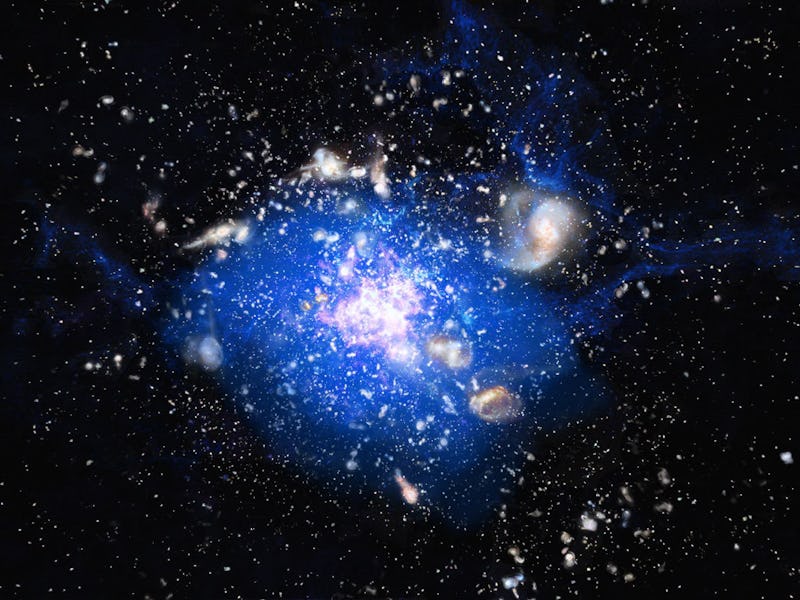A Giant Galaxy is Growing 10 Billion Light-Years From Earth

In the heart of a cluster of embryonic galaxies lies a cosmic behemoth, and no, we don’t mean a supermassive black hole. An international team of astronomers studying a cluster of galaxies, with the help of specialized ground-based telescope arrays, stumbled upon a nest of infant galaxies — known as protogalaxies — while they were still forming more than 10 billion years ago. The team discovered a giant galaxy swimming in a sea of surprisingly-dense molecular gas soup in the middle of the cluster.
Named the “Spiderweb Galaxy,” scientists predict that one day, this intricate web of galaxies will collapse into itself to form a single, massive galaxy, much larger than the one at its heart. The findings will be published Friday in the issue of the journal Science.
“This is different from what we see in the nearby universe, where galaxies in clusters grow by cannibalizing other galaxies. In this cluster, a giant galaxy is growing by feeding on the soup of cold gas in which it is submerged,” says Bjorn Emonts of the Center for Astrobiology in Spain, leader of the international research team.
Artist conception of the spiderweb. Protogalaxies are shown in white and pink, with carbon monoxide gas shown in blue.
Using observations from the Australia Telescope Compact Array (ATCA) and the National Science Foundation’s Karl G. Jansky Very Large Array (VLA) radio, astronomers detected an abundance carbon monoxide (CO) gas.
Data shows that the molecular gas reserves in this galaxy cluster span three times the size of the Milky Way and has a mass of more than 100 billion times that of the sun. Astronomers also discovered that the gas supply was incredibly cold (approximately -200 degrees Celsius), which makes it the perfect material for forming new stars.
“This is a huge system, with this molecular gas spanning three times the size of our own Milky Way Galaxy,” says Preshanth Jagannathan of the National Radio Astronomy Observatory (NRAO) in Socorro, New Mexico.
Thanks to the combined data from both the ATCA and the VLA observations, the team discovered another surprise: Two-thirds of the cold gas was distributed between the galaxies, which are merging with the larger one. Also, the gas represents a supply that has been upcycled after earlier generations of stars (within the galaxies) went supernova.
These results shed light on current theories of galaxy formation. Previously, giant galaxies were thought to grow by cannibalizing smaller galaxies. However, in recent years (and thanks to the help of computer simulations) astronomers now think that early in its formation, the stars within massive galaxies could have condensed directly out of large reservoirs of gas. It appears that the Spiderweb galaxy is forming in much the same way, and the team predicts that the whole system eventually will collapse into a single, gigantic galaxy.